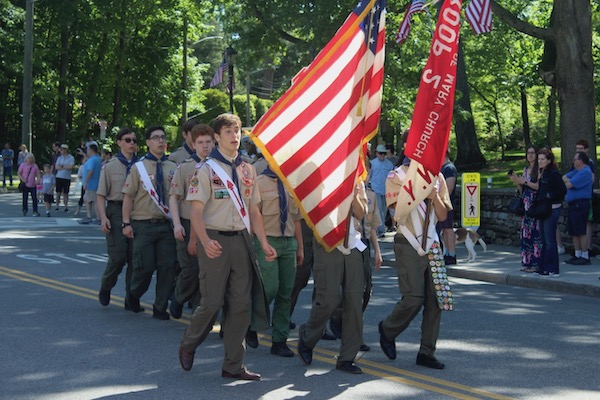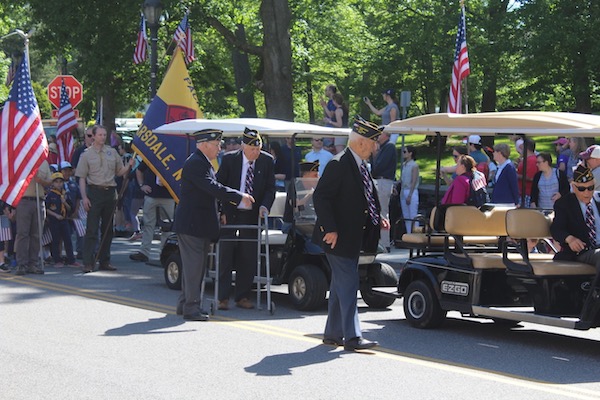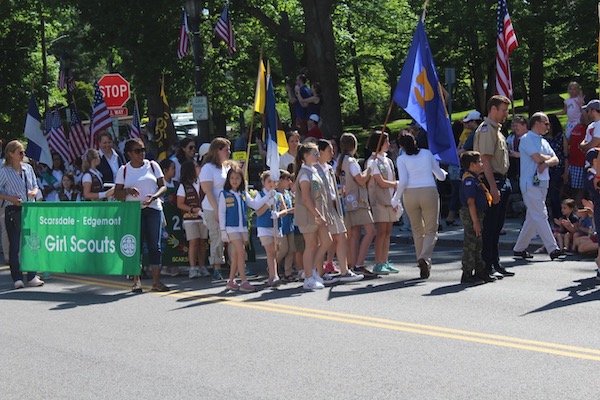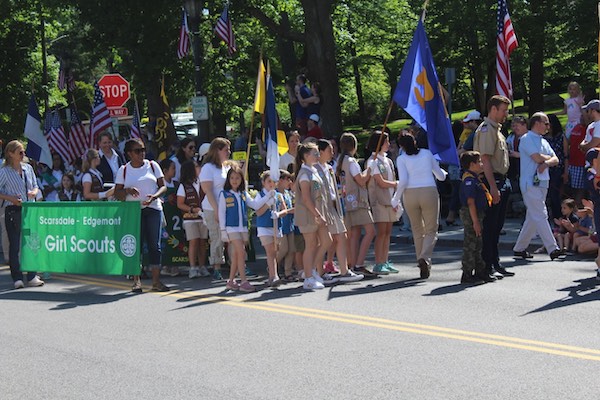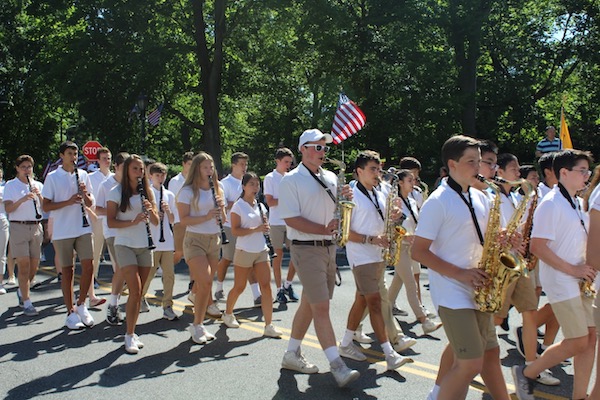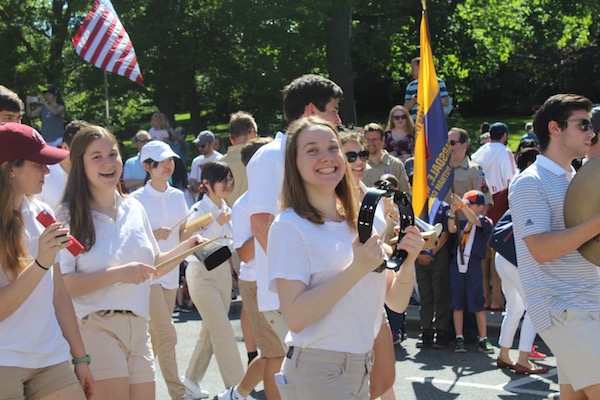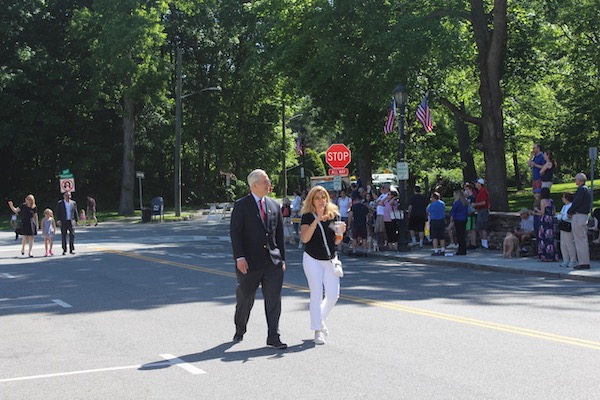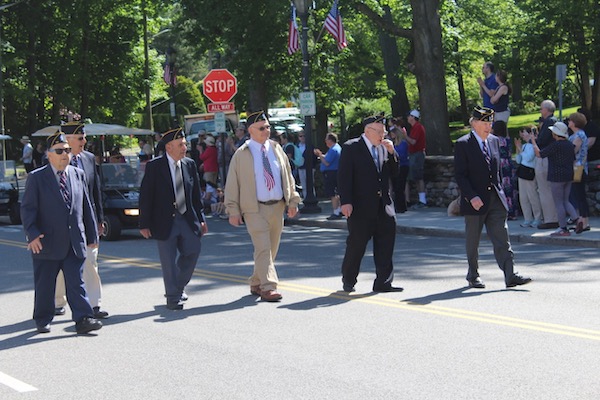A Glorious Memorial Day Parade
- Details
- Written by Jamie Robelen
- Hits: 4074
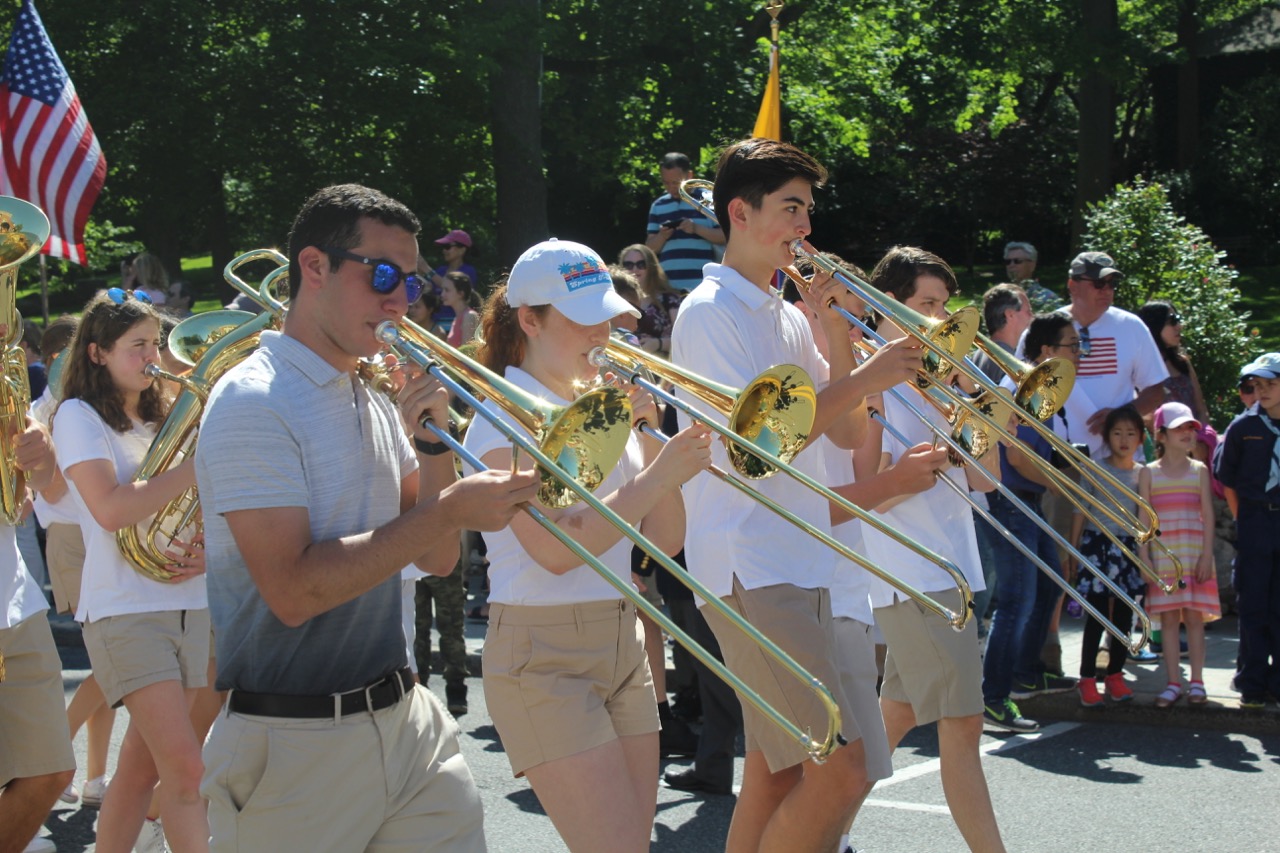 On a glorious Memorial Day, Scarsdale residents lined the streets of Scarsdale Village to watch the annual Memorial Day Parade on May 27th, 2019.
On a glorious Memorial Day, Scarsdale residents lined the streets of Scarsdale Village to watch the annual Memorial Day Parade on May 27th, 2019.
The parade lined up in the Village and began with a flag raising and ceremony at Boniface Circle, concluding with TAPS in Chase Park. Many different groups and people participate in the parade, with students, adults, and seniors alike all marching. Mayor Marc Samwick led the parade followed by Village Trustees Justin Arest, Jonathan Lewis, Jane Veron and Rochelle Waldman. The parade featured members of American Legion Post 52, led by Commander Tom Adamo. Some veterans marched while others rode in golf carts. Village Manager Steve Pappalardo, Deputy Village Manager Rob Cole and flag bearers from the Scarsdale Police and Fire Departments were in attendance as well as former Mayors and Trustees. There was a troop of Girl Scouts and a few troops of Boy Scouts, some older and some younger.
As usual, the parade was accompanied by the Scarsdale High School band playing classic American tunes.
It was a beautiful day for the people of Scarsdale to gather in Chase Park. Afterwards, many people went to Lange’s for a last meal before it will close on Friday. As a community, Scarsdale came together to honor all who have served our country.
Planners and Managers Provide Update on the Status of Development at Freightway Site
- Details
- Written by Joanne Wallenstein
- Hits: 4103
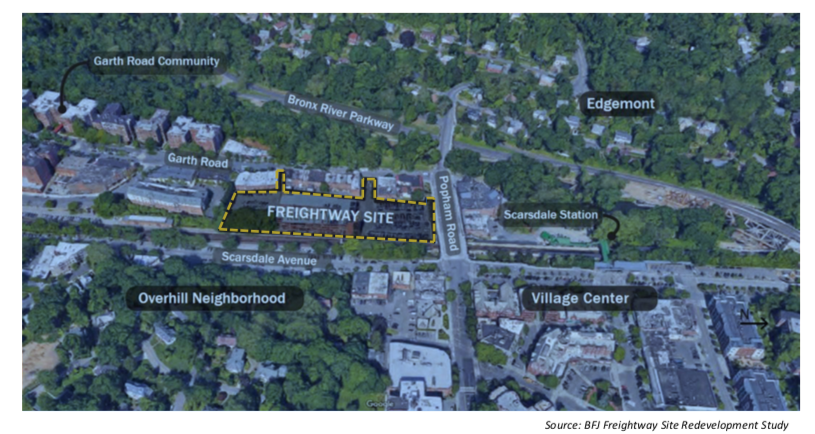 What is the status of an initiative to build a transit-oriented development on the west side of the Metro North tracks in Scarsdale Village? In order to keep the public informed about the process, the Scarsdale Board of Trustees scheduled a public forum on Wednesday May 15 with Village Managers and recently-hired planning consultants AKRF, to review what’s been done to date – and what’s in store for the next few years.
What is the status of an initiative to build a transit-oriented development on the west side of the Metro North tracks in Scarsdale Village? In order to keep the public informed about the process, the Scarsdale Board of Trustees scheduled a public forum on Wednesday May 15 with Village Managers and recently-hired planning consultants AKRF, to review what’s been done to date – and what’s in store for the next few years.
The site under consideration is 2.5 acres of Village owned property at Freightway, plus another 1.33 acres and the air rights over the railroad tracks. The deteriorating indoor lot, outdoor spaces and open lots accommodates 720 commuter cars, and one of the biggest concerns about the development project is where all these commuters will park during the construction project.
Over the past several years the Village has already done outreach to residents to identify priorities for the new development, assigned a steering committee to establish goals and objectives, held public workshops, fielded an online survey and done a visioning study.
Last year the Village received responses from seven firms to an RFI, and has rough concepts from these seven developers to consider. The plans included residences, retail locations and parking as well as public spaces including 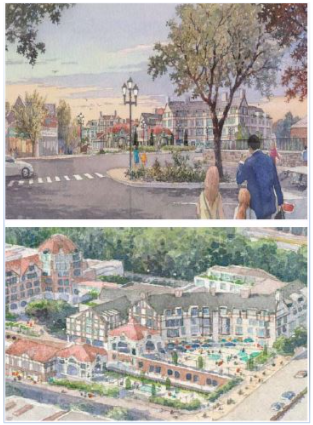 A rendering from the response to the RFI from East End Capitalparks, walkways, parks and open air plazas.
A rendering from the response to the RFI from East End Capitalparks, walkways, parks and open air plazas.
Since that time, the Village has retained McCullough, Goldberger and Staudt LLP as legal counsel and AKRF as planning consultants to help the Village evaluate the proposals.
Assistant Village Manager Ingrid Richards explained that the Village is “almost halfway through the process of developing an RFP that reflects the values of this community.”
Some of the key goals to improve the Village Center include:
-Aesthetics
-Place-making
-Connectivity
-Sustainability
Residents want a vibrant village center with green energy and green infrastructure.
Their next step is to finalize the RFP and circulate it to selected developers. It has not yet been decided whether it will go only to the seven applicants who submitted an RFI or to other bidders as well.
The proposals will be evaluated on the basis of:
-Extent to which the proposal meet Village criteria and aligns with vision and principles
-Prioritizes connectivity, open space, placemaking, sustainability, fiscal benefit and contextual design.
-Developer has demonstrated experience and competency
-Proposal offers best value in terms of finances and community benefit
-Developer experience with creating long lasting projects.
Once the SEQRA or environmental study is reviewed, there will be a public hearing on the zoning change. The developer will then file a site plan for approval.
Mayor Marc Samwick emphasized, “There is a long process in front of us – we are at the top of the second inning. We have an enormous opportunity to evaluate what is to be done”…. He added, “The Christie Place project was almost a parking garage paid for by us. Instead we have residences, retail, parking and real estate tax revenue of more than $1 million a year. (Referring to Freightway he said,) “Do we want to just get parking – or get the parking plus more additional benefits? That’s why we are here today.”
During the public comments portion of the meeting, residents expressed concerns about the project and hopes about what might be included.
Bob Berg said, “My big fear is that we give a developer free rein to do what is most profitable for them – and they make many multi family houses. Coops and rentals get a big tax break. Condominiums would not be a problem if we pass the Homestead Act.” He asked, “Are you going to restrict the housing in the RFP to condominiums to avoid this problem?”
Ed Morgan, President of the Scarsdale Arts Council asked the Board to “bring back a modern movie theater with a performance space in it. Freightway is one of the sites that should be looked at for a facility like the Jacob Burns Film Center
Bob Harrison suggested that the Board consider an indoor aquatic facility aka an indoor pool for the community. He said, “Can this be worked in?”
Andrew Sereysky said, “One of the proposals mentioned a dog run – this has been a pet peeve of mine. Scarsdale needs a dog park! Include a dog park during the process.”
Carol Silverman said, “What about a senior center or a community center?”
Zoltan Szilagyi of Chesterfield Road said, “I appreciate the transparency. Consider the importance of school enrollment –-- it is such an overriding concern. Have realistic enrollment projections in advance for informed decision making.”
Berg then returned to the mic to discuss the Homestead Act. He said, “At Christie Place, the units were sold on the premise that their property taxes would be very reasonable. That’s the same scam you want to pull off here.”
Trustee Justin Arest responded saying,
Commenting on the Homestead Act, Trustee Justin Arest said he believed it was “premature to have this discussion,” first because Homestead can only be considered following a municipal wide revaluation, and Scarsdale is not currently planning another reval. Second, “the probability for a Westchester municipality adopting it is relatively small.”
Furthermore, he said, “Whether it be in the form of public amenities and/or a potential up front payment, it behooves us as a community to balance our aesthetic and density concerns with maximizing revenue- in other words, making the pie and our piece of the pie larger. If homestead was implemented today, it would lead to an increase in the tax liabilities faced by any proposed condo units and therefore cause significant reductions in their value.”
Therefore he concluded, “Just the conversation of automatically opting for Homestead and giving the false impression that there is wide community support for it could lead developers to amend their base case that they will use to underwrite the project and materially change the proposals we receive.”
Addressing Berg he said, “I don’t appreciate your statement that we are trying to pull off a scam or cheat anyone. Bait and switch is not our intent.”
Mayor Marc Samwick explained, “There is a certain amount of value to the land the village owns. That value can be achieved in parking fees or real estate taxes. We are not going to get both – how are we going to maximize the value? We are putting the cart before the horse with a discussion of Homestead. We have to look at this in a responsible fashion based on the tax structure we have today. Let’s stay focused on what we know, quantify it and evaluate it and move forward. All options will be compared to a “no build” option so it will be clear how much the development is costing the Village.”
Tama Seife of Circle Road said, “What about the dislocation for people who park there? Is that part of the impact study?”
She was assured that, “Yes that is part of the environmental review – and mitigations need to be designed to minimize those impacts. How can we make this better? What are the tradeoffs?”
Tom Giordano of Montgomery Road asked if civic groups can provide input for the RFP.
David Buchen of Circle Road asked, “Are any of the private owners interested in contributing? What will the Village own at the end of the process? What is the capacity of the train station? We are the second most frequented train station on the Harlem Line after White Plains. How much more traffic can be brought to that station?”
Anne Zink of Beechwood Lane said, “Newer residents may not have the opportunity to supply feedback. When does the window close for the public to submit their wish list?
She was told, “The window does not necessarily close on identifying impacts. The Village hasn’t set forth a specific program – i.e. a dog park or a pool – instead we are asking the development community of their ideas of a good use of this land.”
See the full presentation on the Village website here.
Protecting the Victims of Hate Crimes: LWVS Luncheon on Friday May 10
- Details
- Written by Joanne Wallenstein
- Hits: 2972
 The League of Woman Voters of Scarsdale cordially invites you to its Annual Meeting and Luncheon on Friday, May 10, 2019, 11:45 AM - 2:00 PM at Scarsdale Golf Club in Hartsdale.
The League of Woman Voters of Scarsdale cordially invites you to its Annual Meeting and Luncheon on Friday, May 10, 2019, 11:45 AM - 2:00 PM at Scarsdale Golf Club in Hartsdale.
FEATURED SPEAKER: Cynthia Deitle, Speaking about Protecting the Victims of Hate Crimes: A Career in Seeking Justice
Cynthia M. Deitle supervises the national hate crime programs and outreach as the Programs and Operations Director for the Matthew Shepard Foundation. Prior to joining the Matthew Shepard Foundation in 2017, for 22 years Cynthia was a Special Agent with the Federal Bureau of Investigation, where she specialized in civil rights enforcement, community outreach, and victims’ assistance.
At the FBI, Cynthia served as the lead investigative agent for many high-profile police brutality investigations and investigated hate crimes cases. In 2007, she assumed a Supervisory Special Agent position in the Civil Rights Unit in FBI Headquarters.
In 2008 Deitle was promoted to Civil Rights Unit Chief, where she managed the FBI’s national cases and investigation of Hate Crimes, Color of Law, Human Trafficking and Abortion Extremism Programs. As Civil Rights Unit Chief, she also worked the FBI’s Cold Case Initiative which seeks to reexamine unsolved racially-motivated homicides from the Civil Rights Era.
Following passage of the Matthew Shepard and James Byrd, Jr. Hate Crime Prevention Act of 2009, Deitle collaborated with Dennis and Judy Shepard, The Department of Justice, the Anti-Defamation League, NAACP and other non-governmental agency stakeholders, to train state, local, and federal law enforcement officials to enforce this law. In 2011, Deitle transferred to the Boston Division to supervise the Public Corruption and Civil Rights investigations in Massachusetts, Maine, Rhode Island and New Hampshire.
Deitle received her Bachelor of Arts degree from The Ohio State University and her Juris Doctor degree from New England Law Boston. She earned a Master of Laws degree in Criminal Law from New York University School of Law and a Master of Laws degree in Constitutional Law from the George Washington University National Law Center.
Deitle has published several law review articles on the right to bear arms under the Second Amendment and the use of excessive force by police in the context of the civil rights laws.
Tickets are $40.00 per person; $45 after May 7; Student Price $20.00. Click here to register online or download the form and mail it in with a check.
Bring The Family To See Bye Bye Birdie This Weekend At SHS
- Details
- Written by Jamie Robelen
- Hits: 5612
 L to R: Danielle Lemisch as Deborah Sue, Becca Skar as Kim, Amanda Ruzumna as Margie, Julia McMurray as Helen, Amanda Glik as Suzie, Emily Lattman as Alice, Talia Schulhof as Nancy, Ben Schwartz as ConradThe SHS senior class musical is a tradition that Scarsdale kids look forward to every year. It’s a chance for students who aren’t involved in drama at the high school to have their moment onstage to shine, and it’s also a chance for kids who are involved with the drama club to step into production and leadership roles. This year, the show picked was the 1960 classic musical Bye Bye Birdie. The show will open on Friday, May 17th, at 7:30pm. There will also be performances on Saturday, May 18th at 7:30pm and Sunday, May 19th at 2:00pm. The production is directed by senior Katie Nova in her directorial debut, with technical supervision and mentorship throughout the process from Mr. Steve Bogardus.
L to R: Danielle Lemisch as Deborah Sue, Becca Skar as Kim, Amanda Ruzumna as Margie, Julia McMurray as Helen, Amanda Glik as Suzie, Emily Lattman as Alice, Talia Schulhof as Nancy, Ben Schwartz as ConradThe SHS senior class musical is a tradition that Scarsdale kids look forward to every year. It’s a chance for students who aren’t involved in drama at the high school to have their moment onstage to shine, and it’s also a chance for kids who are involved with the drama club to step into production and leadership roles. This year, the show picked was the 1960 classic musical Bye Bye Birdie. The show will open on Friday, May 17th, at 7:30pm. There will also be performances on Saturday, May 18th at 7:30pm and Sunday, May 19th at 2:00pm. The production is directed by senior Katie Nova in her directorial debut, with technical supervision and mentorship throughout the process from Mr. Steve Bogardus.
 Christina Coco as Mae Peterson, Noam Cherki as Albert PetersonThe plot of the show follows Albert Peterson, a songwriter for the pop star Conrad Birdie, his girlfriend and secretary Rosie Alvarez, and Conrad himself, as they put together one last publicity stunt before Conrad goes to war. Their big idea is for Conrad to have one last “goodbye kiss” with a fan, Kim MacAfee, which stirs things up with Kim’s family and newly-steady boyfriend, Hugo. The production stars Noam Cherki as Albert, Lindsay Gelles as Rosie, and Ben Schwartz as Conrad, featuring Becca Sklar as Kim and Joey Lane as Hugo, with Simon Krohn and Izzy Riback as Kim’s parents and Zach Reyman as Kim’s brother. While some members of the cast have outside theatre experience, for many it’s their first show.
Christina Coco as Mae Peterson, Noam Cherki as Albert PetersonThe plot of the show follows Albert Peterson, a songwriter for the pop star Conrad Birdie, his girlfriend and secretary Rosie Alvarez, and Conrad himself, as they put together one last publicity stunt before Conrad goes to war. Their big idea is for Conrad to have one last “goodbye kiss” with a fan, Kim MacAfee, which stirs things up with Kim’s family and newly-steady boyfriend, Hugo. The production stars Noam Cherki as Albert, Lindsay Gelles as Rosie, and Ben Schwartz as Conrad, featuring Becca Sklar as Kim and Joey Lane as Hugo, with Simon Krohn and Izzy Riback as Kim’s parents and Zach Reyman as Kim’s brother. While some members of the cast have outside theatre experience, for many it’s their first show.
The senior class has been working hard to put this all together. The whole family will enjoy it! To see the show, buy tickets here or at the door on May 17th, 18th, or 19th.
Volunteers Plant Native Trees and Shrubs in Scarsdale
- Details
- Written by Todd Wolleman
- Hits: 3143
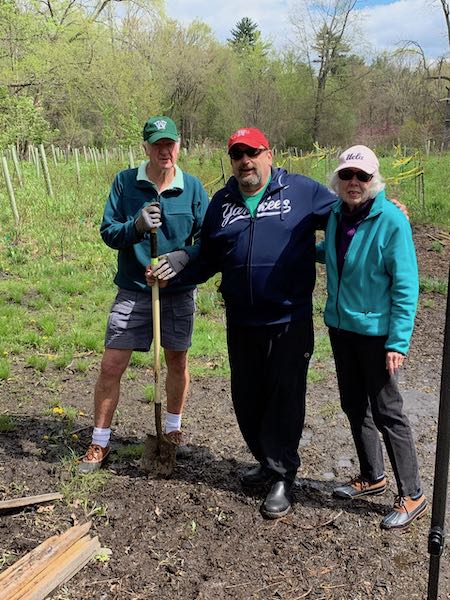 Rick Reuter, Todd Wolleman and Kay Eisenman on Planting DayThe Friends of Scarsdale Parks held their fifth annual planting day at Scarsdale High School on Saturday April 27. The Friends have been reclaiming a waste site adjacent to Dean Field and the Scarsdale Library, clearing it of knotweed and replacing invasive plants with native trees and shrubs. It is now a beautiful meadow. This year, with the help of the Village naturalist, they planted native Sycamores, Northern Arrowwood (viburnum), Cranberries, red twig dogwoods and plum rose bushes along the watercourse. Scarsdale’s first couple, Mayor Marc Samwick and his wife Cynthia stopped by to see the progress of this communal effort. Over the course of the day, 50 people lent a hand and a shovel to the planting effort.
Rick Reuter, Todd Wolleman and Kay Eisenman on Planting DayThe Friends of Scarsdale Parks held their fifth annual planting day at Scarsdale High School on Saturday April 27. The Friends have been reclaiming a waste site adjacent to Dean Field and the Scarsdale Library, clearing it of knotweed and replacing invasive plants with native trees and shrubs. It is now a beautiful meadow. This year, with the help of the Village naturalist, they planted native Sycamores, Northern Arrowwood (viburnum), Cranberries, red twig dogwoods and plum rose bushes along the watercourse. Scarsdale’s first couple, Mayor Marc Samwick and his wife Cynthia stopped by to see the progress of this communal effort. Over the course of the day, 50 people lent a hand and a shovel to the planting effort.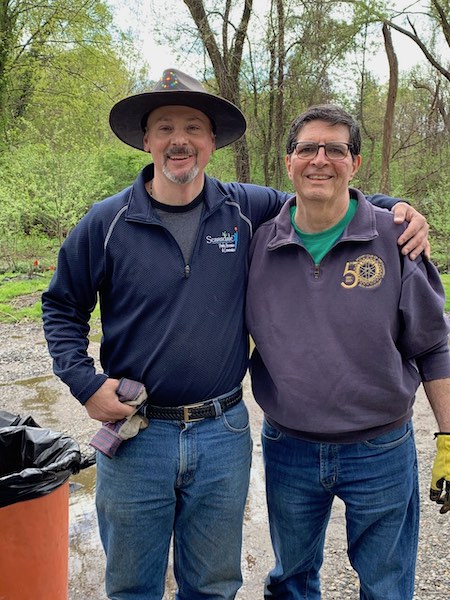 Village Naturalist Sam Weinstock and Dan Girardi
Village Naturalist Sam Weinstock and Dan Girardi












